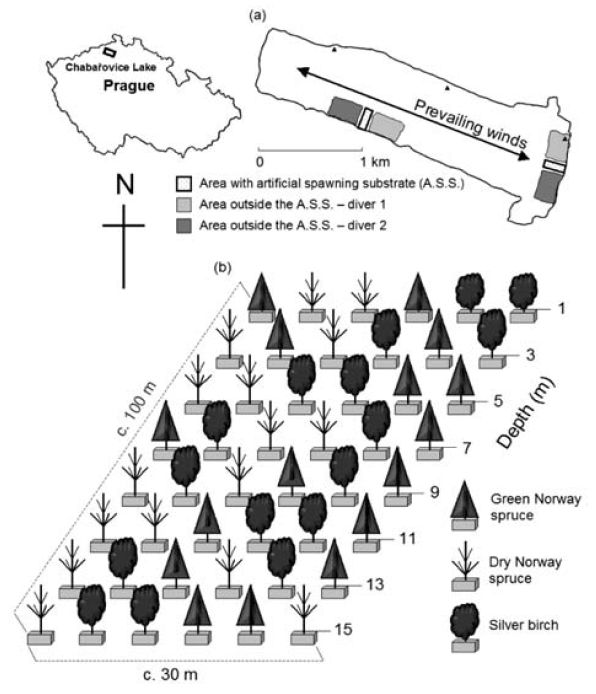 The distribution of egg strands of perch Perca fluviatilis and factors affecting this distribution, in terms of spawning sites and spawning depths used, was studied in spring 2010 in Chabařovice Lake, Czech Republic, using areas with an artificial spawning substrate (A.S.S.) and control areas outside the A.S.S. Perch significantly preferred a calm shore instead of a windward shore for spawning. The depths at which perch egg strands were found increased significantly during the spawning period in both A.S.S. areas and in areas outside the A.S.S. (on average from 4.9 m at the beginning to 12.3 m at the end of the spawning period). With increasing depth of deposition the size of the egg strands decreased significantly. The mean depth of egg strands on individual dates corresponded to the position of 10-12°C water layers. From the third week onward, however, egg strands were deposited in much deeper and colder water. A strong relationship was found between the depth at which egg strands were deposited and the duration of the daylight period, indicating that, at the end of the spawning season, perch do not react to the actual temperature of the water column but that they follow their inner clock, assuming that “normally” the shallower depth layers are too warm for successful embryo development. Factors influencing the depth distribution of egg strands were identified as waves, temperature and duration of the daylight period. Factors influencing the selection of spawning sites were identified as wind inducing current, internal seiches and temperature instability of the water column. The first perch larvae were present in the open water of Chabařovice Lake before mid-May, and the latest larvae not earlier than the beginning of July, since warming of the water in deeper layers was very slow. It appears that with prolonged spawning and hatching periods and with spawning occurring at various depths and temperatures, perch have evolved a powerful mechanism to protect their population against the vagaries of the weather and temporary bad biological conditions in the lake.
The distribution of egg strands of perch Perca fluviatilis and factors affecting this distribution, in terms of spawning sites and spawning depths used, was studied in spring 2010 in Chabařovice Lake, Czech Republic, using areas with an artificial spawning substrate (A.S.S.) and control areas outside the A.S.S. Perch significantly preferred a calm shore instead of a windward shore for spawning. The depths at which perch egg strands were found increased significantly during the spawning period in both A.S.S. areas and in areas outside the A.S.S. (on average from 4.9 m at the beginning to 12.3 m at the end of the spawning period). With increasing depth of deposition the size of the egg strands decreased significantly. The mean depth of egg strands on individual dates corresponded to the position of 10-12°C water layers. From the third week onward, however, egg strands were deposited in much deeper and colder water. A strong relationship was found between the depth at which egg strands were deposited and the duration of the daylight period, indicating that, at the end of the spawning season, perch do not react to the actual temperature of the water column but that they follow their inner clock, assuming that “normally” the shallower depth layers are too warm for successful embryo development. Factors influencing the depth distribution of egg strands were identified as waves, temperature and duration of the daylight period. Factors influencing the selection of spawning sites were identified as wind inducing current, internal seiches and temperature instability of the water column. The first perch larvae were present in the open water of Chabařovice Lake before mid-May, and the latest larvae not earlier than the beginning of July, since warming of the water in deeper layers was very slow. It appears that with prolonged spawning and hatching periods and with spawning occurring at various depths and temperatures, perch have evolved a powerful mechanism to protect their population against the vagaries of the weather and temporary bad biological conditions in the lake.
Keywords: aquatic vegetation; Chabařovice Lake; Chara vulgaris; common stonewort; Eurasian water milfoil; lake management; Myriophyllum spicatum; SCUBA diving
